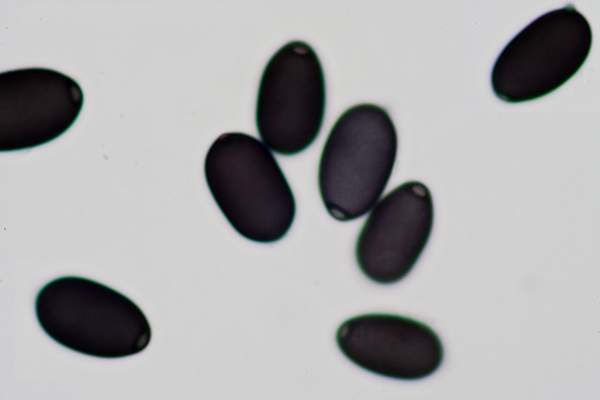Coprinus sterquilinus (Fr.) Fr. - Midden Inkcap
Phylum: Basidiomycota - Class: Agaricomycetes - Order: Agaricales - Family: Agaricaceae
Distribution - Taxonomic History - Etymology - Identification - Culinary Notes - Reference Sources
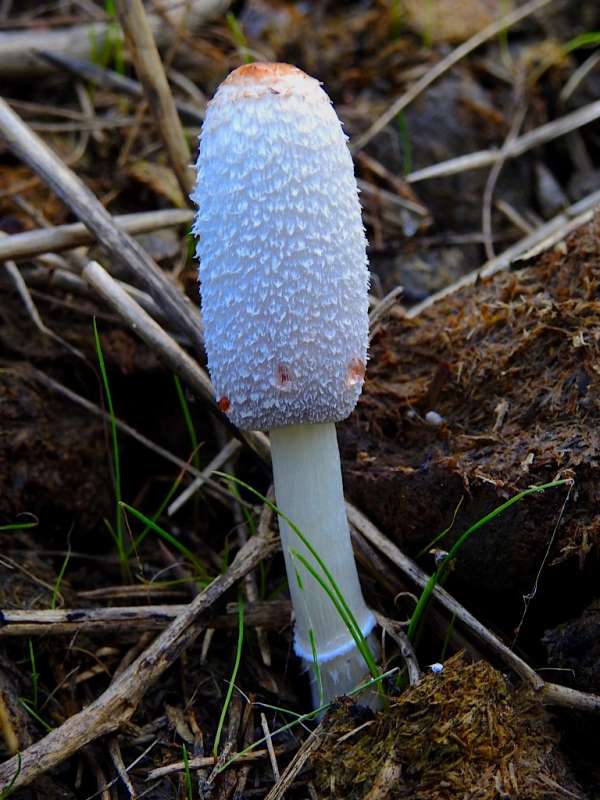
This inkcap, a smaller look-a-like of the terrestrial Coprinus comatus, was probably far more common in the period when it was named by Elias Magnus Fries in 1838. It may be sensitive to agro-chemicals etc., and it is now rarely reported. Coprinus sterquilinus was included in the Red Data List of vunerable species in 2006.
Distribution
A widespread but rarely reported fungus, this young specimen was found and photographed on unimproved grassland in the New Forest.
Taxonomic history
The scientific name Coprinus sterquilinus was applied to this species by Elias Magnus Fries in 1838, since when it has remained unchanged.
In the era before motor vehicles, when horses were the main form of transport, the local domestic tip would contain a fair amount of horse dung and rotting vegetation. These tips were known as 'middens', and early records show that this is where Coprinus sterquilinus could be found - hence the common name Midden Inkcap.
After the taxonomic re-evaluation of the Coprinus genus in 2008 by Redhead, Vilgalys & Moncalvo, this fungus and Coprinus comatus are the only members of the genus Coprinus reliably found in Britain.
Etymology
The generic name Coprinus means 'living on dung' - that's true of many of the inkcaps and quite apt for this species.
The specific epithet sterquilinus means 'of dung heaps'.
Identification guide
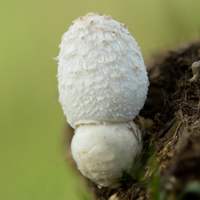 |
CapInitially egg-shaped and opening into a bell shape, the shaggy caps of Coprinus sterquilinus are at first pure white. Typically 2-6cm tall and 1.5-3cm wide, the white caps darken and become fibrillose and open to a somewhat plicate final shape, looking like many other inkcaps at this stage. The cap is also prone to reddening with damage and age. GillsThe adnexed to free gills of Coprinus sterquilinus are crowded and initially white; they soon turn pink and then black before deliquescing (liquefying) from the outside edge. |
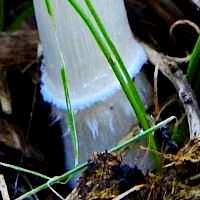 |
StemThe stem of the Midden Inkcap widens downwards with a basal bulb, 6-15cm tall and 3-10mm in diameter; white, with a loose narrow ring. In the photograph above only the basal bulb of the stem is visible. |
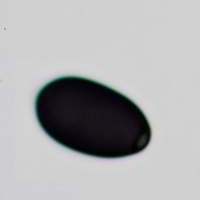 |
SporesEllipsoidal, smooth, 17-22 x 10-13µm; with a germ pore positioned centrally or slightly eccentrically. Spore printBlack. |
Odour/taste |
Faint and quite pleasant, but not distinctive. |
Habitat & Ecological role |
This saprobic mushroom has been found on weathered horse dung, occasionally with rabbit dung, and on rotten plant debris. The earliest reports of this fungus on the FRDBI are from the 19th century, when it was found on local tips. An important identification feature is that this fungus is found on weathered dung rather than on the ground. |
Season |
Not enough record information but possibly occurring year-round, most likely spring to autumn. |
Similar species |
The Shaggy Inkcap Coprinus comatus is the closest lookalike when young, but the Shaggy Inkcap is found on soil and has smaller spores. |
Culinary Notes
We should not be eating anything that is rare and vunerable (whether it grows on dung or elsewhere!).
Reference Sources
Keys to Parasola, Coprinellus, Coprinopsis and Coprinus in Britain D.J. Schafer 26th June 2009.
Funga Nordica, Henning Knudsen & Jan Vesterholt 2012.
Dictionary of the Fungi; Paul M. Kirk, Paul F. Cannon, David W. Minter and J. A. Stalpers; CABI, 2008.
English Names for fungi; British Mycological Society, 2013.
Taxonomic history and synonym information on these pages is drawn from many sources but in particular from the British Mycological Society's GB Checklist of Fungi.
Acknowledgements
This page includes pictures kindly contributed by David Kelly and Marika Lewis.
Fascinated by Fungi. Back by popular demand, Pat O'Reilly's best-selling 450-page hardback book is available now. The latest second edition was republished with a sparkling new cover design in September 2022 by Coch-y-Bonddu Books. Full details and copies are available from the publisher's online bookshop...
